![]()
![]()
![]()
Use LEFT and RIGHT arrow keys to navigate between flashcards;
Use UP and DOWN arrow keys to flip the card;
H to show hint;
A reads text to speech;
11 Cards in this Set
- Front
- Back
- 3rd side (hint)
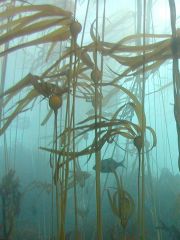
|
Bull Kelp Nereocystis luetkeana
DISTINGUISHING FEATURES: Long cylindrical stipe that gradually increases in diameter from the holdfast to pneumatocyst (float); single large floats contain 2 groups of up to 50 blades each. Blades are smooth, long and narrow. RCCA Notes: Stipe must be at least 30cm to the top of the bulb to count. SIZE: Stipe up to 118 ft (36 m) and blades 13 ft (4 m) in length (5). DISTRIBUTION: Alaska to central California in the subtidal zone (5). INTERESTING FACTS: Nereocystis (Greek for mermaid's bladder) achieves its maximum length in one season by growing approximately 7 in (17 cm) per day. The large float contains carbon monoxide, a toxic gas (5). HARVEST: Commercial harvest of bull kelp in California began in the late 1980s. It is used as abalone food and in liquid fertilizer. Other uses involve the thick central stalk which is pickled and marketed as a food product and dried portions used in arts and crafts (10).STATUS: Unknown (10). |
Stipe must be at least 30 cm from the holdfast to the top of the bulb to count. |
|
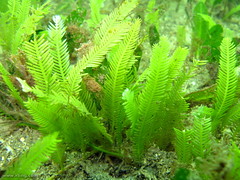
|
Caulerpa Caulerpa taxifolia DISTINGUISHING FEATURES: Bright green color, rubbery texture, feather-like fronds and horizontal runners called stolons. DISTRIBUTION: C. taxifolia was first found and identified in California in 2000 in Agua Hedionda Lagoon in Carlsbad and in Huntington Harbor, Orange County. Genetic tests indicated it was the highly invasive aquarium strain that has invaded other locations around the world. It was eradicated from these sites in 2006, but can easily be introduced again through careless aquarium disposal.Why is C. taxifolia a problem? Caulerpa taxifolia was accidentally released into the Mediterranean Sea from a saltwater aquarium. Today, the invasion covers over 30,000 acres of seafloor, smothering diverse native species and dramatically reducing biodiversity. The eradication of this same species from California cost over $7 million. Because Caulerpa contains toxins that make it unpalatable to many grazing animals that feed on other seaweeds, it encounters no native predators in the waters it invades.If you find Caulerpa in the wild: Note as much information as possible (location, depth, bottom type, size of the patch); if possible, record the location with a GPS and make a map, carefully collect a small piece, press it flat in newspaper and take a photo.Report sighting to: www.sccat.net, NMFS 562-980-4043, CDFG 858-467-4218, Rachel Woodfield 858-560-5465, rwoodfield@merkelinc.com. |
Bright green color, rubbery texture, feather-like fronds and horizontal runners called stolons. INVASIVE - Note if on or off transect and mark location. |
|

|
Giant Kelp Macrocystis pyrifera DISTINGUISHING FEATURES: Elongated thallus with alternating long, wrinkled blades that have floats at their base. M. pyrifera has a conical holdfast (structure used for substratum attachment) with branched root-like projections (haptera). RCCA Notes: While surveying, stipes are counted for each individual plant one meter up from the holdfast. SIZE: Southern individuals up to 180 ft (55 m), northern up to 99 ft (33 m) (5). DISTRIBUTION: Alaska to Baja CA, but more common south of Monterey CA. Found on the rocky substrate from 20 to 100 ft (6 to 30 m) (13). INTERESTING FACTS: It is a source of algin, a thickening, stabilizing, suspending and gelling agent in many food and industrial products (3). HARVEST: Giant kelp was historically one of CA’s most valuable living marine resources. In 2001, the kelp harvesting industry was valued at more than $30 million annually (3). The harvest of this kelp is regulated by the Department of Fish and Wildlife, and only the upper 4 ft (1.2m) may be taken (9). STATUS: The density and abundance of kelp vary by location, year and season. El Niño events and recent warming trends affect kelp populations but do not fully account for patchy distributions in different areas along the coast. Surveys indicate populations are declining, particularly in southern CA (10). |
While surveying, stipes are counted for each individual plants one meter up from the holdfast. |
|
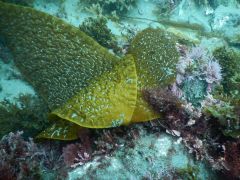
|
Laminaria farlowii DISTINGUISHING FEATURES: L. farlowii’s blade pattern is generally simple with no veins or bifurcations. The adult stage is characterized by one single, relatively short, unbranched stipe from which one large blade grows. Blade texture may vary from wrinkled to smooth. RCCA Notes: L. farlowii must be at least 30cm long, including blade, to count. SIZE: Length 16ft (5m) with a stipe of 4-7cm. DISTRIBUTION: Alaska to Baja CA, from low intertidal to subtidal (5). INTERESTING FACTS: L. farlowii is a dominant brown algae in white abalone habitat, thus giving this species ecological importance (15). STATUS: Unknown. |
Blade pattern is generally simple with no veins or bifurcations. The adult stage is characterized by one single, relatively short, unbranched stipe from which one large blade grows. Must be at least 30cm long, including blade to count. |
|
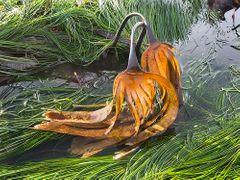
|
Laminaria setchellii DISTINGUISHING FEATURES: L. setchellii is characterized by one medium sized stipe from which one round, smooth, blade grows. The blade is uniformly torn into strips resembling the palm of the hand and the stipe can grow up to one meter. RCCA Notes: L. setchellii must have a 30cm long stipe to count. SIZE: Length 16ft (5m) with a stipe that can grow up to one meter. DISTRIBUTION: Alaska to Baja CA, from low intertidal to subtidal (5). HARVEST: Laminaria has a long history of extensive farming as a sea vegetable in Asia. North American production of Laminaria continues to increase. China produces about one quarter of the world’s demand for iodine from this kelp (5). STATUS: Unknown. |
The blade is uniformly torn into strips resembling the palm of the hand and the stipe can grow up to one meter. Must have a 30cm long stipe to count. |
|
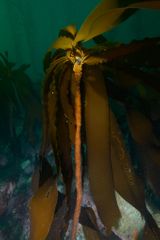
|
Pterygophora Pterygophora californica DISTINGUISHING FEATURES: This brown alga has a long, woody, unbranched stipe that starts cylindrical at the base and becomes flattened near the terminal blade. The blade is long, smooth and strap-like. RCCA Notes: When surveying, must be at least 30cm to top of the woody stipe to start. SIZE: Stipe 3-7 ft (1-2 m) and blades 2 ft (60 cm) in length (13). DISTRIBUTION: Cook Inlet, Alaska to Baja California. Generally found in the rocky subtidal from 7-66 ft (2-20 m) (13). INTERESTING FACTS: Native Americans of the Northwest used to know this species as the walking kelp because of the way it moves in its shallow habitat. They would also place Pterygophora in rows to guide salmon into traps (5). HARVEST: Not applicable. STATUS: Unknown. |
When surveying, must be at least 30cm from holdfast to beginning of blades to count. |
|
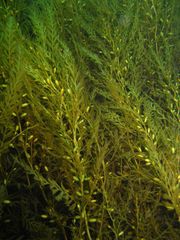
|
Sargassum horneri DISTINGUISHING FEATURES: The young plants have symmetrical (fern-like) fronds with a notched tip. Older specimens are 1+m tall and loosely branched, with small oval bladders and long, finger-like receptacles. Look for the zigzag shape of the frond, it is unique to this species. RCCA Notes: On an kelp survey, plant must be 30cm tall to count. DISTRIBUTION: The brown S. horneri is native to Asia. This species was spotted in Long Beach Harbor in October 2003. In April 2006, it was found near the Wrigley Marine Science Center, Cherry Cove and Emerald Bay on Santa Catalina Island at depths of 12-40 ft (4-12 m). As of 2016, it is widespread at Catalina and San Clemente Islands and is patchy at Anacapa Island and various mainland coastal and bay locations. STATUS: Invasive species new to California. |
Look for the zigzag shape of the frond, it is unique to this species. Bladders look like little chili peppers. INVASIVE - Record if seen on or off transect. Count on transect if 30cm or taller. |
|
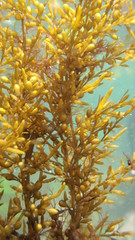
|
Sargassum muticum DISTINGUISHING FEATURES: This brown algae is olive-brown to yellowish with a maximum length of 33 ft (10 m) (16). It has small spherical pneumatocysts (float bladders) among small, alternating, leaf-like blades. RCCA Notes: Can be distinguished from S. horneri as it has alternating blades rather than flat fern-like blades. The float bladders are generally oval in shape in S. muticum but are chilli-pepper shaped in S. horneri. Note if seen anywhere on site. DISTRIBUTION: The brown S. muticum is native to Asia. This species was spotted off of Catalina Island 1970. In 1973, it was found in San Francisco Bay. As of 2017, it is widespread in Southern California and Baja California intertidal and shallow subtidal waters (28). STATUS: Invasive species with varying impacts on native populations (28). |
Thallus bushy, elongated, yellowish-tawny to dark brown,. Tough, cylindrical, repeatedly alternately pinnately branched. Rounded-elliptical air bladders rather than the cylindrical bladders of Sargassum horneri. INVASIVE - Record if seen on or off transect. |
|
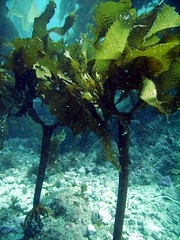
|
Southern Sea Palm Eisenia Arborea DISTINGUISING FEATURES: Rubbery body that is cylindrical at the base and splits into two prominent branches at the top. Attached to the branches are wrinkled blades with dentate margins. Eisenia’s Y-shaped stipe distinguishes it from other species such as Pterygophora. RCCA Notes: When surveying, stipe must be 30cm to the base of the “Y” to count. SIZE: Stipe up to 5 ft (1.5 m), and blades to 1.3 ft (40 cm) (5). DISTRIBUTION: Patchy along the west coast, from British Columbia to Baja California. Mainly found on rocky substrate from the lower intertidal into the subtidal area (5). INTERESTING FACTS: A marine iguana of the Galapagos Islands feeds on an Eisenia species (5). It was named southern sea palm because at one point it was thought to only occur south of Point Conception (13). HARVEST: There is no commercial or recreational harvest of this species in California. STATUS: Unknown. |
When surveying, if stipe is 30cm from the holdfast to the base of the “Y”, record as >30cm; if less than 30cm, record as <30cm. |
|
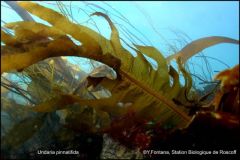
|
Undaria Undaria pinnatifida DISTINGUISHING FEATURES: The blade is thin, deeply lobed and has a prominent mid-rib. There are tiny dots (tufts of hairs) scattered on the surface of the blade. The reproductive part is just above the holdfast; it is deeply folded and looks like an Elizabethan collar. RCCA NOTES: Note if on or off transect. SIZE: It can be 3-6 ft (10-20 m) long. DISTRIBUTION: This brown algae, native to Asia, has spread around the world to Australia, New Zealand, Europe, South America and California’s harbors. INTERESTING FACTS: Undaria appears in late winter. The blade grows through spring and begins to erode in late summer. Also known as Wakame, this seaweed is often used in soup. HARVEST: In Asian countries harvested for salads and soups (16). STATUS: Invasive. If you find Undaria, please take a picture and contact:Dr. Kathy Ann MillerUniversity HerbariumUniversity of CaliforniaBerkeley, CA 94705510-643-7007 |
The blade is thin, deeply lobed and has a prominent mid-rib. There are tiny dots (tufts of hairs) scattered on the surface of the blade. The reproductive part is just above the holdfast; it is deeply folded and looks like an Elizabethan collar. INVASIVE - Record if seen on or off transect. Note location. |
|
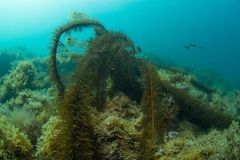
|
Feather Boa Kelp Egregia menziesii DISTINGUISHING FEATURES: Numerous small blades line the long flattened stipe, giving the species a furry, feather boa-like appearance. The blades are around 5cm long, and range from broad to thin and pine needle-like. It is anchored into place by a large holdfast that can reach up to 25cm across. It ranges in color from olive green to dark brown. RCCA Notes: Must be one meter high to count. Like giant kelp, stipes are counted for each individual plant one meter up from the holdfast. SIZE: Length up to 15m long, but generally shorter (30). DISTRIBUTION: Common on lower intertidal rocks from midtidal to subtidal (20m). E. menziesii is often found mixed with Macrocysis. Its range stretches from Alaska to Punta Eugenia, Baja California (33). INTERESTING FACTS: The tall-shelled limpet, Notoacmaea incessa, lives and feeds on the surface tissues of feather boa kelp, producing oval scars or pits (40). STATUS: Unknown. |
Looks like a fashion accessory. Must be one meter high to count. Like giant kelp, stipes are counted for each individual plant one meter up from the holdfast. |

